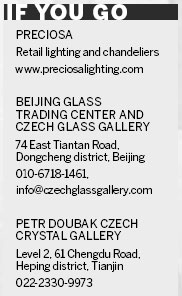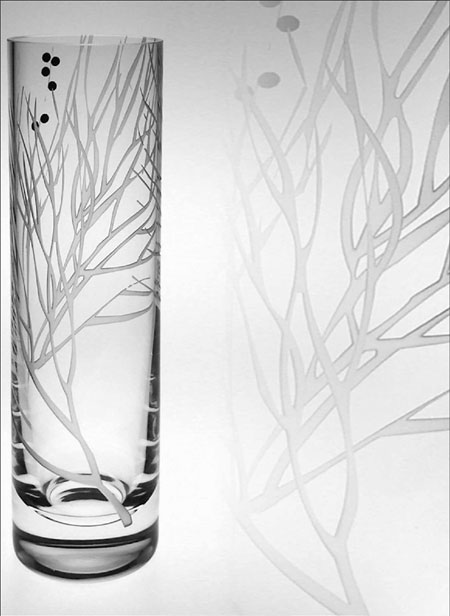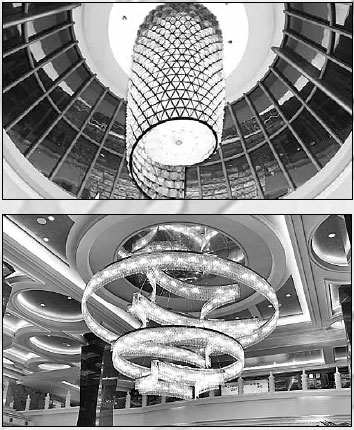Simply luminous
Updated: 2013-06-02 08:02
By Mike Peters(China Daily)
|
|||||||
|
Jan Hebnar, partner of Czech Glass Gallery. Feng Yongbin / China Daily |
|
The classic chandeliers in Nanyuan Hotel in Ningbo and Sheraton Shenzhen. Photos Provided to China Daily |

Many five-star hotels in China have flown in chandelier specialists from Prague for their renovation works. But the appeal of art glass is not restricted to only the rich and famous, as Mike Peters finds out.
Fine crystal has been a sign of elegant taste since medieval times, when Bohemian kings were Holy Roman Emperors. Bohemian artisans discovered that local potash combined with chalk created a clear, colorless glass that was more stable than glass from elsewhere in Europe. This non-lead glass could be cut with a wheel, and the region (later part of Czechoslovakia and now the Czech Republic) has produced craftsmen and crystal, famous for superb cut and engraving.
The appeal of art glass lives on today, and you don't need to be decorating a palace to savor its crystalline beauty.
It's true that a wave of renovation at many of China's five-star hotels have kept chandelier specialists from Prague glued to the ceilings of ballrooms from Shenzhen to Beijing in the past year.
But China's booming economy has stimulated an influx of artful glass for style-conscious homeowners, too, from elegant light fixtures to classic tableware.
"We are more concentrated on the custom-made lighting than on retail," says Preciosa Lighting's David Sutr. "However, you can find (and buy) some of our products in DaVinci shops." They include residential-scale chandeliers.
While some fixtures flaunt styles that might be at home in a concert hall, the trend is toward sleeker, contemporary looks - even in top hotels. Preciosa's recently installed focal point of the ballroom of the Nanyuan Hotel in Ningbo, for example, is a spiral of 51 versions of pyramids and 280 light sources that cascade over 11 meters toward the ground.
Lasvit, a leading Czech manufacturer of contemporary light fittings with Bohemian traditions of glass-making, has also been busy in China's luxury hotels. Two Czech engineers flew to Xiamen last fall to supervise local installers of an intricate constellation of glass that took six weeks, and were immediately off to Suzhou for the next ballroom bling job.
In the retail market, Atelier Zampach, founded in 1990 by the artist Stanislav Zampach, is a family-owned glassmaker specializing in limited-series production and custom orders for company gifts, awards and sports trophies. Atelier Zampach is available at some malls in big cities in China.
Bohemian Glass is one of many shops at the Beijing Glass Trading Center, a specialty mall near Beijing's Temple of Heaven that boasts a broad selection of tableware, from heirloom styles that hipsters might dismiss as frumpy to sleekly contemporary stemware.
Gold-trimmed goblets are sought after by shopping brides and their mothers, a status symbol that can run to thousands of yuan for a complete dinner set. But most pieces are priced more affordably.
Decorative art glass is making inroads in China, too. Two recently opened venues, the Czech Glass Gallery in Beijing and the Petr Doubak Czech Crystal Gallery in Tianjin, feature one-of-a-kind works by contemporary glass artists.
The Czech Glass Gallery, located on the second floor of the trading center in Beijing, features many artists and hosts occasional exhibitions, plus a high-tech line of Bomma tableware from about a dozen different designers.
The etching is done by machine, says Czech partner Jan Hebnar, "but the crystal is so fine that it must be done very slowly - so slowly that it's more expensive than some handwork. The sleek glasses and goblets run about 500 yuan ($82) each, though cheap copies have found their way into the marketplace.
"You can detect them with your fingernail," Hebnar says. "If the glass is a fake, the 'etching' will actually be painted on."
Contact the writer at michaelpeters@chinadaily.com.cn.

(China Daily 06/02/2013 page13)

